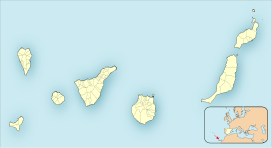Pico de las Nieves
| Pico de las Nieves | |
|---|---|
 |
|
| Highest point | |
| Elevation | 1,949 m (6,394 ft) |
| Prominence | 1,949 m (6,394 ft) |
| Listing | Ultra |
| Coordinates | 27°57′43″N 15°34′18″W / 27.96194°N 15.57167°WCoordinates: 27°57′43″N 15°34′18″W / 27.96194°N 15.57167°W |
| Geography | |
| Location | Gran Canaria, Canary Islands, Spain |
| Geology | |
| Mountain type | Stratovolcano |
Pico de las Nieves is the highest peak of the island of Gran Canaria, Canary Islands, Spain. Its height is 1,949 metres (6,394 ft) above sea level. The origin is volcanic (stratovolcano). On its slopes, Canary Islands Pine was reintroduced in the 1950s. It is the highest elevation of the province of Las Palmas and the third highest mountain in the Canary Islands. Of the other Canary Islands, only Tenerife and La Palma have higher peaks.
The name means 'peak of the snows' in Spanish and refers to the fact that several covered pits (neveras in Spanish) for holding snow were built directly into the mountainsides. (An alternative theory states that the name came about as the mountain had the highest frequency of snowfalls on the island.) The first of the neveras was constructed in 1694 by order of the Church. The snow was collected by laborers using wooden shovels and wicker baskets, making real mountains of snow. The snow was placed into the pits by the "paleros" in rows, and packed in rectangular boxes of wood or cork separated by layers of straw. They were many blocks of ice, called "sabanada" which in June would be carried in panniers of straw covered with blankets to the ice cream shop in Cathedral of Las Palmas (capital of the island) on horseback, that took five or six hours. The snow was used for alleviating disease, to lower the temperature in the epidemics of yellow fever and cholera, as well as anti-inflammatory and analgesic. It was also used as a refreshing, for cooling water or beverages made that were offered to the authorities or upper class individuals. Water from these pools was then used for irrigation purposes.
Most of the highest plateau is occupied by a military base, including a large ball-shaped radar. Civilian visitors are allowed to enter a platform somewhat below the base, from which half of the island as well as Tenerife's Pico del Teide is visible, in case of good weather. The most distinctive feature is the Roque Nublo monolith, the second highest peak of the island.
The peak could be accessed by a car, as there is a road used by the army. The peak is located between the municipalities of Tejeda, Vega de San Mateo and San Bartolome de Tirajana.
...
Wikipedia

